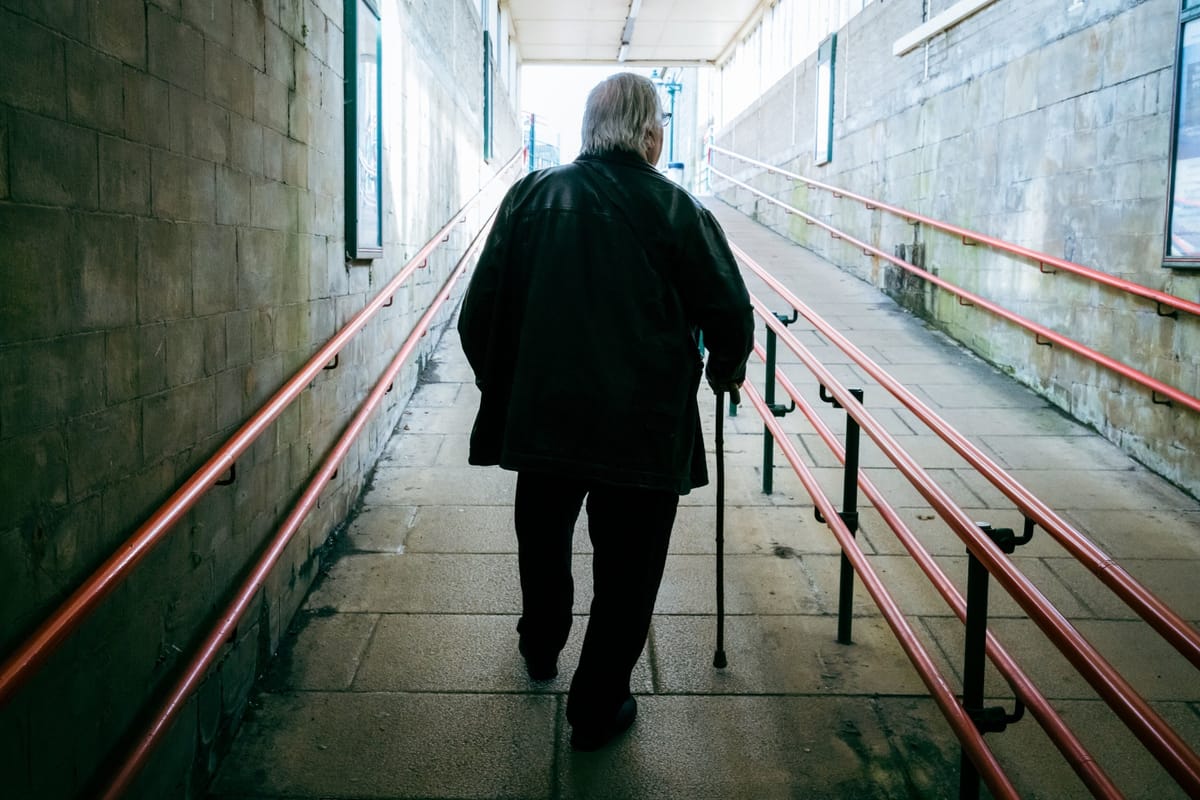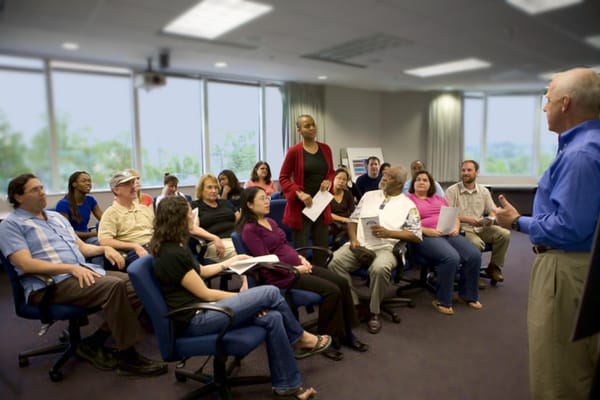What Is Inclusive and What Is Not

Accessibility goes beyond checking a box. It defines dignity and participation in society. Unfortunately, even those who claim to favor social justice often use the disabled as caricatures and props. Sometimes, they become cudgels. Bad-faith actors cite the disabled to shame the opposition, but this action serves the speaker and actively harms actual people with challenges.
Transcript
Jonathan: The Yellow Light Sound, “What Is Inclusive and What Is Not.”
The Americans with Disabilities Act passed in 1990, and eighteen years later came some amendments. It has now been seventeen years since then. Should we update our understanding of accessibility? I’d like to talk about why I care about this when I can walk and have above-average sight and hearing. (I don’t suffer from any physical disabilities.) Then I will explain how it hurts us all when someone makes a bad faith defense of people with disabilities. First, I know that different people have different attitudes on wording.
Some will casually throw around a word like disability, and others will chafe. They would prefer to hear differently abled. Others want to avoid any stigma.
They want to call a spade a spade, and they do not want to hide from the word disability. They’re not ashamed of having low vision, for example. So why do I care? I don’t care because I have some physical challenge, and it’s not because I’m close to somebody with a challenge—a spouse, a child.
I care because it’s relatively small to care about these things. It doesn’t cost a lot, and it is such a game changer for people with certain challenges. It might be a little more expensive to have a ramp for that three-inch step up into the building, but you know, when you’re making the building from scratch, you can afford that.
It’s a small thing, but it’s huge. It makes all the difference. Somebody can go from not being able to enter your building to being able to enter your building.
And this isn’t just about the most visible form of disability, the wheelchair. We see the blue placard signs with the stick figure and the wheelchair. That’s what we think.
That’s the be all and end all of disability. Well, no. A ramp can also be helpful to people who have some motor difficulties.
Say, somebody can walk, but maybe not as well, or maybe somebody is very old and uses a cane. I’m sure that person would prefer to have a gradual step up, well, a gradual ramp up, than to have an abrupt step that’s three or four inches off the ground. So that’s part of it.
The other thing, too, about why I care is that there is the curb cut effect. Now, the curb cut effect is named after, well, literally that—curb cuts. It used to be that in cities when you had sidewalks, when the sidewalks met the roadway, when they met the street, there would be a sudden dropoff.
There wasn’t a ramp on or off of it. That was the norm. And if you have limited mobility, that’s intolerable.
You can’t get around if that’s the case. So how about we have ramps at intersections now? Well, by the time I was born and I grew up, those were quite commonplace. I could see the advantages in those.
I didn’t know why they were there, originally. I just thought, Oh, it’s kind of nice, especially if you have a dog and you’re trying to get something heavy. Well, they got a little ramp up.
There has to be a ramp somewhere to get on the sidewalk. It’s great. Also, by the time I came of age, it was very common to see those bumps, those things they would put at live intersections.
You would see these bumps all over. Sometimes they’d be brightly colored, sometimes not. But there’d always be these bumps that had a different texture from the rest of the road.
I thought, oh, well, this is nice. So when it’s very rainy or icy, if you’re in that type of climate, well, the ramp is no longer a danger because now you’ve got these better grips for you. I was in my thirties, I think, when somebody explained, no, no, no, no.
Those bumps aren’t there for, well, they are there for safety reasons, but they’re originally put there so that people who have low vision can tell when the sidewalk ends, where the intersection starts. They can feel their cane, they can feel their feet, they know, oh, this is the end of the sidewalk. If I take another step, I will be on the blacktop instead of the cement sidewalk.
That’s their curb cut effect. It helps us all, even if we don’t realize that it was originally for other people, had other people in mind. This was a huge game changer for certain groups, but everybody benefited.
Nobody says, “Oh, I wish they did not have these bumps.” Nobody really says that. Maybe if you want to count the money, but it’s so small, it’s a drop in the bucket.
Curb cuts, those are great. I don’t want to be a part of making the world more unwelcoming. It’s already the case that people who have certain challenges are going to struggle with many things.
If you go to the typical movie theater, it probably will not have subtitles. If you’re hard of hearing or completely deaf, that’s huge. You will not have the same experience going out to the movie theaters with your friends.
Now, people may say, “Oh, there are special theaters here and there or special screenings that have subtitles,” but it’s not there by default. It’s not there everywhere. If you have the resources to put up subtitles or have sign language interpreters at a live event, then have that.
It always was great to me how in Korean political debates, there would be a live interpreter. And that’s even better than closed captioning because Newsflash, nobody wants to read nonstop. It doesn’t matter if you have normal hearing or not.
You don’t want to just read that nonstop. It’s also not the way you communicate with people. It’s just, it’s almost like a different language.
Well, it’s not just, it is. The syntax, the grammar of American sign language is different from other sign languages, even if those are Anglophone countries. Sign language is its own thing.
And when you have a little bubble in the corner, and we can do that now with HDTV quite easily. You can send somebody a live feed, a camera, somebody who’s doing live sign language interpretation of what people say. That’s really great.
And while I’m on the topic of Korean TV, something that I appreciate as somebody who’s much better at reading Korean than hearing Korean is that it’s standard to have subtitles, captioning, whatever—you want to say. There is a text form whenever somebody’s speaking on the news. It’s just standard.
An interview, an announcer, you’re going to have subtitles for many things. It makes it more accessible, something that makes a huge difference.
When you’re able to be aware of what’s going on around you, when you’re able to stay up to date on various events, you can participate in society. I was not a citizen, so I didn’t have, for example, as you would see in the USA, jury duty. But when you have trials without sign language interpretation, “Oh, whatever, you’re hard of hearing, you’re excused, you don’t have to serve.”
Well, sometimes you do want to serve, or maybe you’d like to have somebody wonder, “Oh, maybe he or she will be on the jury.” It’s nice to feel part of society, not a special charity case all the time. Why can’t we do that in more places? You know, just the courthouse itself, I mentioned sign language, but you could also have ramps.
And I don’t mean ramps that you put off to the side, oh, well, technically there’s also a ramp here, it’s where we get deliveries, and also people who use wheelchairs can use that. No. Why does the front have to be such that it tells anybody with physical challenges, you’re not welcome here? It’s not for nothing that as a result of civil rights movements, we no longer had segregated water fountains or entrances.
That’s a thing in a lot of old houses, not just racially, but class-wise too. “Oh, that’s where the help comes, that’s for the help, that entrance, that exit, that back side entrance, the nice regal front entrance, that’s for the well-to-do.” That’s why I care.
Now what do I do? I make a decision every time I produce content to have transcripts for the audio content and to have audio voice-overs for the essays. I don’t want to make the content just for one audience. People might say, “Oh, it’s just a minority, who cares. It’s just a small thing.”
And yeah, maybe it is, but as I’ve said, they have a lot of other things in life that are hard. I don’t want to add to that inconvenience. Why should I? And we don’t have to think about disabilities as a total binary.
“Oh, you’re completely blind or you can see perfectly without eyeglasses.” “Oh, you can hear perfectly or you’re deaf as a post. No, there is a line in between.”
And we also have people who learn languages. Korea was a lot more accessible to me because of all the subtitling everywhere. If somebody is not a native speaker of English, yeah, maybe that person can catch 80% of an audio broadcast.
But if there are subtitles to read along, maybe that person will get 98%. You know, if you can do the subtitles, if you can do the transcripts, then why not? The excuse for not doing it is going away very quickly as we see these advancements in chatbots or LLMs or generative AI, whatever you want to call it. I actually wish AI had gone more in that direction.
Unfortunately, the money is going towards plagiarizing art, plagiarizing written work, giving confident but false information, or doing things that will make it feasible for you to fire your secretary. That’s what AI is doing now. There’s not as much money in subtitling, live transcriptions, et cetera, but it’s good enough for a lot of purposes.
I see, unfortunately, an abuse of AI. Well, there’s a big one with NaNoWriMo. NaNoWriMo is National Novel Writing Month.
Every November, this organization puts on a Novel Writing Month. I don’t want to go over all the details, but suffice it to say, this organization, as of April 2025, is shutting down. Its most recent contest last fall had this controversial inclusion of AI or promotion of AI, whatever you want to say.
The organization was okay with having more AI in the generation of content. If you know about AI and how it works, you will know that it trains itself by looking at existing material. That has its own ethical issues, of course, but what was really strange was NaNoWriMo justified its position by saying, “Oh, you don’t want to be classist or ableist and be anti-AI.”
Well, is the implication here that you need AI to write for you because if you are blind, you can’t write well, you can’t come up with good stories, you don’t feel human emotions? I don’t know what they were thinking because that was, it was bizarre. I don’t know if they’re trying to do damage control or what, but it did not go over well. It was not surprising that the organization folded a few months later.
It’s in the process as of this recording to go away. Now if we were talking about AI tools being allowed in the contest of, oh, this is helping people who maybe don’t have the same mobility with their hands, they don’t have dexterous, had a hand amputated, maybe they are low vision and they would like to be able to talk to the computer, you know, the feature is now, why can’t we do that? Well, for a lot of things, we can just talk to the computer, have the computer dictate back to you. That would have been great, but that wasn’t really what the controversy was about.
It was about AI in general, which unfortunately at this point is probably more bad than good for the creative arts. Now that struck me as a bad-faith argument. It was maybe a cost-cutting measure, but it was something that the people who run NaNoWriMo wanted to do.
They just wanted to do it anyway. And then when they got pushback, there’s the accusation that, oh, if you’re against this, you’re being ableist, you’re being classist, you’re doing XYZ. It’s really co-opting the language of the social justice movements, but that’s not the only time we hear bad faith arguments.
That’s like disabilities or people with disabilities, or if they really want to sound progressive, they might use other terminology. The pattern is the same. You see or you hear an organization using language that sounds progressive and is trying to shame critics by saying, "Oh, they’re not progressive; they’re heartless, this, that, the other thing," when really they have ulterior motives.
I don’t know what the exact goal was for NaNoWriMo. So, I’m just talking about what seemed to be the case. It seemed as if NaNoWriMo wanted to incorporate some AI tools or give them a blessing.
And then after the fact, after the pushback said, “Oh, it’s about accessibility.” Well, we see the same thing with the way we design roads, the way we design streets, the way we design the built environment, the shops you go to, all of that. People may say, “Oh, well, you know, not everybody can walk, not everybody can ride a bike. So, it’s more accessible to make everything car-dependent.”
Now, that’s clearly from somebody who’s just not familiar with somebody who uses a wheelchair. Yes, there are custom minivans and yes, for a lot of long distance trips in many parts of North America, it’s more feasible to get a specially modified van and have an elevator or hand controls, whatever it takes and use that because there may not be a train from Montana to Minnesota that you can ride. I get that.
But for ordinary life, having more cars, more car dependency does not help much. The custom van that you need to run every single errand. Well, when everything’s really far apart in your town, you’re going to have to get in that van for every errand—post office, bank, corner store—everything.
And when you have more car dependency, you’ve got everybody driving more, and everybody’s competing for the parking spaces. Let me be clear. When I’m talking about getting rid of car dependency, I’m not talking about banning cars.
I’m talking about making it so that not everybody has to drive for every single thing. This will free up space for people who do need cars. Many of us cannot drive safely or choose not to drive or can’t afford a car or want to not have a car for any reason at all—it doesn’t matter.
I don’t have a pilot’s license. I do have a driver’s license for a car, but it would be kind of silly to expect me to learn how to fly a helicopter and to use that to run all my errands.
What makes the car so different? I really don’t see how it helps when you separate the businesses, when every store at a strip mall is so far apart that it’s like a two-hundred-foot walk from one store to the next. You’re telling people, “Oh, okay, walk across this hot blacktop in the sun.” If somebody uses a wheelchair or uses a cane and goes a bit slower, then that person is going to spend more time going through a hot parking lot that may feel like a frying pan in the middle of summer.
If you have more cars, more parking, more dependency on cars, you have less space for sidewalks. And if you have thin sidewalks and you use a wheelchair, you might be in a lot of trouble if somebody backs up a pickup truck so that the back of the pickup truck extends over the sidewalk and the person left the tow hitch in. So, now the pickup truck hangs over, and it’s got a little ball sticking out.
Well, if you use a wheelchair and when you use it, it’s three feet wide. But now this five foot sidewalk is only two and a half feet wide because of this pickup truck overhang. You—you can’t get by.
So people say, “Oh, just go on the grass,” or whatever. Well, not everybody can. Not everybody can do so safely.
And why should people have to inconvenience themselves like that? It’s so backward, really saying this in bad faith. They’re making a bad-faith argument to justify keeping things the way they are because they like to drive everywhere or they think it’s the only way to do anything. And they’re very resistant to change.
And then later, after the fact, they cite disabilities. But when we’re on the topic of disabilities, let’s keep in mind that most disabilities or as I say, most people who have some form of disability will have more trouble driving than with walking. As I said earlier, the ADA logo is that blue and white symbol—blue background, white stick figure on a wheelchair.
Well, there are other disabilities, too, that make it so that you can never drive. You just you just can’t drive. But you can walk even if it’s not bike ride, even if it’s not taking an e-bike, which would solve a lot of problems for mobility.
But let’s just say those don’t exist. You can still be blind and walk. You could still be low vision and walk.
You could be old, struggling with Alzheimer’s and still walk. You could be very young and walk. You could be somebody who has narcolepsy and still walk.
A car might be a little different. Maybe you can, but maybe it’s more uncomfortable for you. The point is, there are so many more disabilities that make it infeasible to drive, but still let you walk or ride a bike.
A person I admire who has spoken on this topic is Anna Zivarts. She is in Washington State, a place where she has to confront the challenges of not driving.
A book she’s talked about is When Driving Is Not an Option. She, after many years, now says she’s openly disabled because of nystagmus. She has a condition which makes it so that her eyes move involuntarily ever so slightly.
It makes her vision blurry. And it makes it so that she can’t perceive depth in the same way. She just cannot drive.
She knows that she would be a danger to herself and others. She had tried once and realized, thankfully, before anybody got hurt, that it just wasn’t feasible for her. She was somebody who would try to hide or, let’s say, make her condition not an overriding feature.
But she has said that she now carries her bright white cane around more often. She finds people who are more helpful when she’s able to, quote, “Look more disabled and in need of help.” But she shouldn’t have to.
Not every disability is immediately visible to everybody. She doesn’t have tinted sunglasses. She’s not blind.
She’s low vision. There’s a difference. It’s a difference that’s enough to make it so that she can walk.
She can ride a bike. Can she drive a pickup truck? No. But that shouldn’t be a qualification to participate in society.
And she represents, I could say, maybe the majority of people who can’t drive because the greatest number of people who have challenges that make them unable to drive are still able to walk. The last thing I wanted to talk about was the bad-faith arguments on physical health.
To be blunt, fatness, obesity. Am I being unfair by demanding that everybody walk? Well, I’m not demanding much other than a more equitable place to live. And if we have things closer together and fewer cars and fewer parking spaces separating the buildings, it’s not as far to walk.
So the idea that people would be expected to jog five miles to work is kind of silly. I’m not advocating that. I don’t think anybody advocates that.
Maybe bike five miles to work, but I’m not expecting people to start jogging everywhere across empty cityscapes where the cars used to roll. No, no, nothing like that. But the thing about weight that gets brought up reminds me of a bad-faith argument that Raj Patel brought up in his book Stuffed and Starved.
I haven’t read the original version, but at least in the second edition, in 2012, he had warned, or maybe he saw the early stages of this, or maybe he just saw where things were going to go and he’s a bit of a prophet. But he has said that the sugar industry and the fast food industry would say that opposition to fatty foods, promotion of physical fitness, promotion of healthier eating habits is racist or classist, which, you know, right off the bat, okay. So, is the implication that being physically fit is the superpower of the majority in America, the majority race? What’s the implication here? So, there’s that.
But, you know, we can hear that today. It’s been a few years since then. And I wouldn’t be the first person to say the word fatphobic.
I’m not suggesting we go back to bullying, ridiculing people. But why should we accommodate and encourage bad habits just because somebody said, “Oh, well, you know, if you’re against eating McDonald’s three times a day, you’re bigoted in some way.” It’s not bigotry.
That’s not it at all. That’s a bad-faith argument. And we should remember that and not be cowed into silence.
Think about what you advocate. Will it make the world more accessible to people or more exclusive? Will it make life more pleasant or will it just continue things as they are? Are we just going to look at accessibility as something to check off on a checklist, or do we want to incorporate that into our thinking?
Copyright 2025 Sae Ong Jee Ma LLC. Opening theme music by Computer Music All-Stars, “May the Chords Be with You.” Released 2018. Available on the Free Music Archive. Closing theme from the Korea Copyright Commission. A 2022 performance of samul-nori music available at Gongyu Madang LSMBG0704. Logo art by Kyle Keswick of Keswick Design Company in Plattsburgh, New York, with edits for contrast and color. Recorded in Plattsburgh, New York.
Credits
Opening theme music by Computer Music All-Stars, “May the Chords Be with You,” released 2018, available on the Free Music Archive, licensed CC BY 4.0. Closing theme from the Korea Copyright Commission, a 2022 performance of samul-nori music, available at Gongyu Madang, LSMBG0704, licensed CC BY-SA 2.0 KR. Logo art by Kyle Keswick of Keswick Design Company in Plattsburgh, New York, with edits for contrast and color. Recorded in Plattsburgh, New York. Copyright 2025 by Sae Ong Jee Ma LLC.





